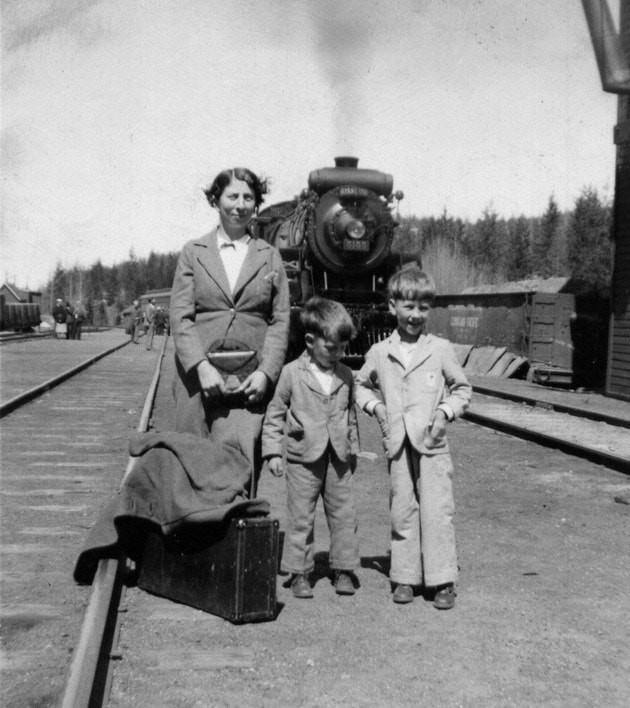After the extension of its Columbia and Western line to Midway in 1900, CPR focused its efforts on developing a maintenance centre at their pass through the Monashees. Farron station was expanded to include buildings for pusher engines and snow plows, a coal storage bin, and housing for visiting as well as resident workers, who looked after rolling stock and maintained Farron Hill.
Among the latter were key personnel that kept the trains running efficiently. Two houses for section-foremen, with responsibilities for track maintenance on either side of the summit, were built next to the station. The station operator was responsible for transmitting operating orders to the trains, as well as other things like ticket sales and telegraph services.
For a young boy, Farron was an exciting place to grow up. Thrilling events stirred the mountain solitude. Trains would arrive and depart, pusher engines would come and go, maintenance workers would head out for their daily tasks. Winter especially was exciting as plows joined the arsenal of powerful machinery. Steam hung in the cold air as the locomotives were being fired up for the everyday struggle against the encompassing snow. Lots of it. And talk of avalanches and snow drifts hummed along the telegraph wires.
John Peterson was that lucky boy, along with his older brother Roy. Their father was Axel Peterson, who had emigrated from Sweden and found work with the CPR. In the late 1920s he became section-foreman, with a house at Coryell that needed filling. He wooed and married Amalia Tedesco, whose family lived down the track near the Fife limestone quarry. Roy was born at Coryell on Dec. 23, 1930. Their second son, John, joined them a year later.
The Peterson family relocated to the much busier Farron station, located right at the top of the grade that took on the name of Farron Hill. Their house was just south of the station itself, and Axel’s section was downhill towards Christina Lake, a stretch plagued by avalanches and landslides. The section-foreman north of the station looked after easier terrain towards Bulldog Tunnel.
Winters had their special charm. An open slope just down the track from the Peterson house provided an ideal run for sledding, although it ran out on the other side of the tracks. John remembers a close call, when he was flying down the hill, unaware the train was leaving the station. The sled tipped when it hit the rail embankment, mercifully spilling its occupant below the track, rather than under the train, where it ended.
In February 1932 an avalanche buried the track some distance south, and had to be cleared away. Axel realized the situation would be far too dangerous for his men and refused to take them there. CPR brought in replacement workers, and three men were buried by the second slide that followed. They all perished.
It was easy for Amalia to retain connections with the family that raised her. Her younger sister, Ersilia, often hopped on the train for a visit uphill. Or Amalia would take the boys down the line to the Tedesco homestead. There the boys could interact with their grandfather, who was a most remarkable man.
Giovanni had worked on the construction of the Columbia and Western Railway in the late 1890s, and followed that employment with work at the limestone quarry, and blasting work for the competing railway, the Great Northern. That job cost him his eyesight in 1908, as a blast went off in his face. After recuperation he bought property at Fife and, with great determination, adapted to look after his growing family in spite of his handicap.
He could not see the children that were born on their homestead, but as they grew, he trained them to help with household tasks. The older boys scouted out and fell trees suitable for firewood. Giovanni would then set out with his dog and cut up the downed logs into manageable sections for hauling home.
There, he would saw them up into blocks that he then split with an axe, holding a block with his left hand and swinging the axe with his right. He never missed. In order to be as self-sufficient as possible, they also maintained a large garden and raised farm animals. The head of the household could weed his gardens, using the sixth sense he had developed in his remarkable fingers.
Although the Peterson children grew up in relative wilderness during a time of economic hardship, their childhood was truly inspirational.
Thanks to John Peterson and Ersilia (Tedesco) Swanson
Walter Volovsek’s website can be found at trailsintime.org
Previous installments in this series
Lilette Mahon: A mentor’s gift
Edward Mahon: Searching for a legacy
Edward Mahon: A stimulating childhood
Intrigues: Castlegar’s lacklustre childhood
Perceptions: Adrift on the River of Life
Local history interwoven with rivers
Drawn into the currents of time
